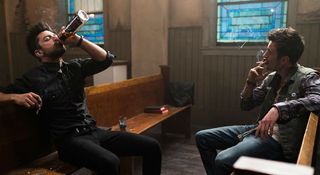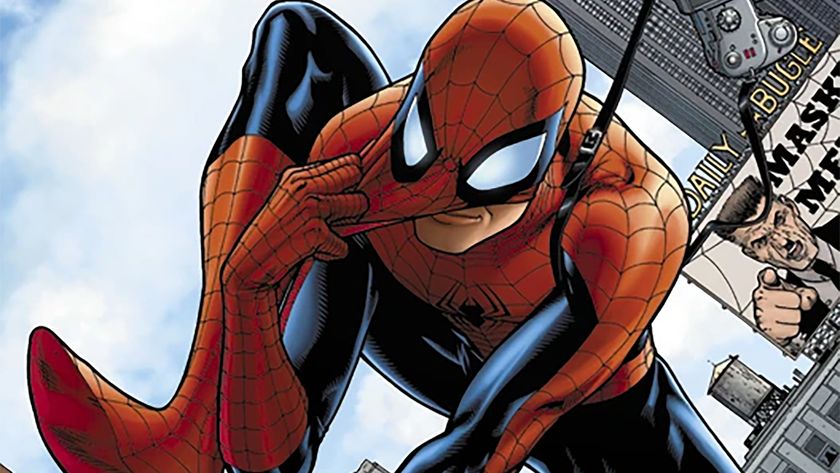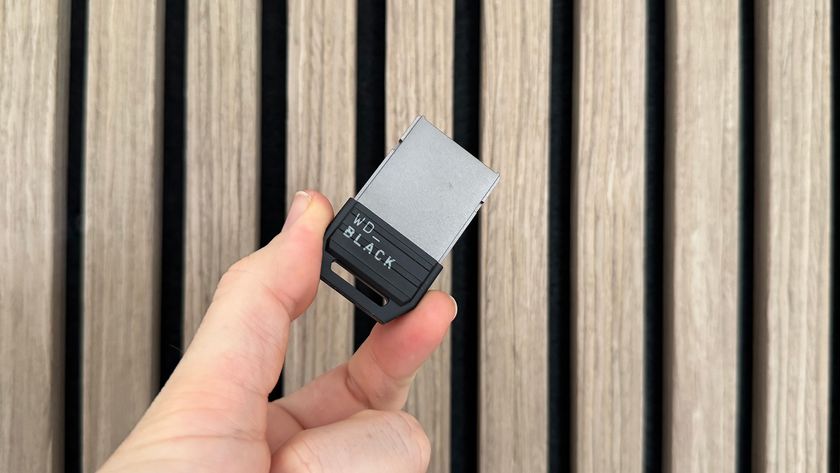Why you can trust 12DOVE
With two of its ten episodes down, AMC’s Preacher has a serious decompression problem. All about packing huge action scenes and loaded, but brief, dialogue into each episode rather than fully developed plots, decompressed stories evoke extreme emotional responses to all that activity but irritatingly never more forward. The classic example is Marvel’s The Ultimates, the big event comics that largely informed the eventual Avengers movie, where a single issue would just be comprised of full page drawings of Iron Man and the Hulk punching each other before Captain America would trade a few one-liner insults with Ant-Man. This kind of decompressed issue is simultaneously tear your hair out exciting and irritating because all those thrills don’t equate to an evolving tale. Preacher’s second episode See is the very worst sort of decompressed story. Fistfulls of new characters show up in scenes totally divorced from Tulip, Cassidy, and Jesse’s ongoing bouts of physical and verbal violence yet nothing changes. Right now, this show has a whole lot happening but doesn’t seem to be about a single damn thing.
The opening minutes certainly seem to set the show on a path, ill-defined as it is. Shifting wildly from the end of the first episode, See begins in 1881 with scenes of a gnarled cowboy leaving his homestead to seek medicine for his sick daughter. Brutal old west imagery of dusty Texas plains and murdered Native Americans counterpoints the silent old cowboy sharing a meal with optimistic homesteaders. All of this creates a nerve-rattling atmosphere that immediately dissipates once the title card disappears and the episode goes on. Fans of the comic will immediately recognize who the cowboy is, but his appearance isn’t connected to anything in the modern day show and it’s just one more disjointed scene in a series of many.
Following the intro to nowhere, See dives down a number of rabbit holes. We rejoin Jesse Custer as he recommits to his church, baptizing congregants, visiting ill parishioners and receiving confession from disturbed and dubiously repentant sinners. Tulip pops back up doing her best to harangue Jesse into backing her up for a still unspecified heist. Cassidy hangs around alternating between gross and charming before indulging in another centerpiece scene of vicious, dirty fighting. This time he roughs up the eerie cowboys with the unplaceable accents that showed up for some cryptic camera mugging at the end of episode one, right after they try to do in a comatose Jesse. They apparently want to hurt him because of the powerful entity that entered him, but even this isn’t explained in satisfying detail.
All of this action with our principal heroes would work if the show followed them with any kind of grace or coherence, but director Michael Slovis and writer/showrunner Sam Caitlin flit between each storyline with the fitfullness of a housefly bumping into a closed window. One second Jesse’s baptizing folks, the next we’re thrust into a scene of some weird old dude demanding people sign over their house to a bunch of intimidating thugs in work coveralls, one of whom horrifyingly assaults another one. We’re never told who any of these characters are, why they’re doing what they’re doing, or how their actions are related to our leads. The only apparent connection is the thugs show up at a local brothel and play cards with Tulip, whose beguiling self-assuredness in the pilot is transforming into aggro manic pixie dreamgirl syndrome the longer we go without seeing her meaningfully interact with anyone beyond sassing them.

The big problems in the first episode are still here. Jesse, Tulip, and Cassidy are empty vessels waiting to be filled up with history for us to actually care about, and all three performers have even less to work with here than they did in the pilot. Jesse’s tentative rage at a dangerous churchgoer doesn’t jive with his conviction to do the “right thing” as he puts it, and his apparent friendship with Cassidy doesn’t seem to be rooted in any kind of real shared experience. They’re friends because the script says they have to be at this point. All three characters are impossible to care about because it’s impossible to tell what they have at stake.
What worked in the first episode works again, though. For two painfully brief scenes, Preacher finds its voice again, namely when Jesse and Cassidy are sharing a drink and talking movies in the church and when Eugene, dubbed Arseface by Cassidy, returns after his baptism asking Jesse why he’s still plagued by guilt and worry. The humanity in both conversations is sorely absent in the rest of this mess of an episode. Everyone watching loses here: fans of the comic get a story that drifts even further from the tone and characters in the source material, while new viewers get a show that’s treading water while trying to get by on spooky goings-on. AMC’s latest is wasting crucial time at this point in the season. Decompression and patient storytelling aren’t bad things on their own, but Preacher’s already used up a fifth of its ten episode season and it can’t afford to dawdle any longer. Giddyup, cowboy, before everyone walks away.

Ex Nintendo PR managers say the Switch 2 generation is likely to see the retirement of "several of the major developers at Nintendo who we have known for 40 something years"

Helldivers 2 CEO says industry layoffs have seen "very little accountability" from executives who "let go of one third of the company because you made stupid decisions"

Spider-Man: Brand New Day - How Peter Parker and Mary Jane's break up led to one of the wall-crawler's most transformative comic eras












